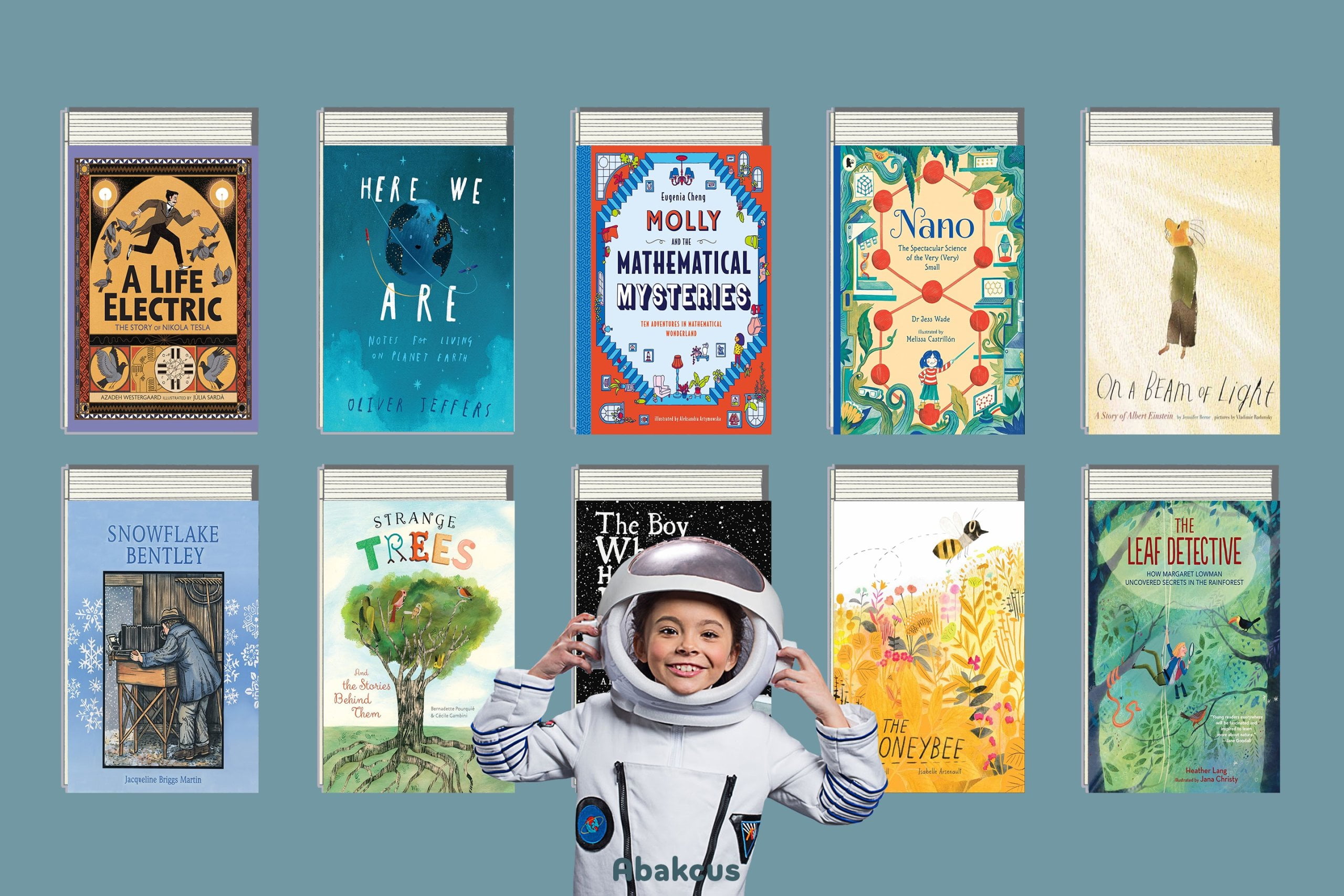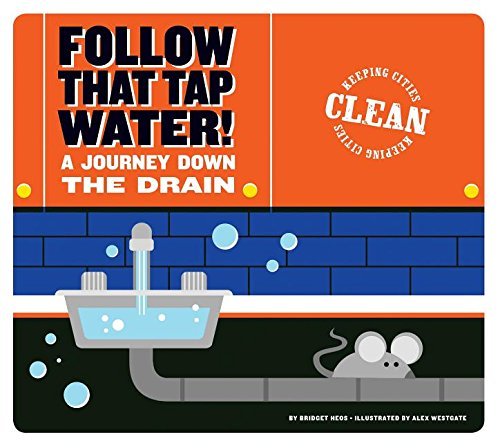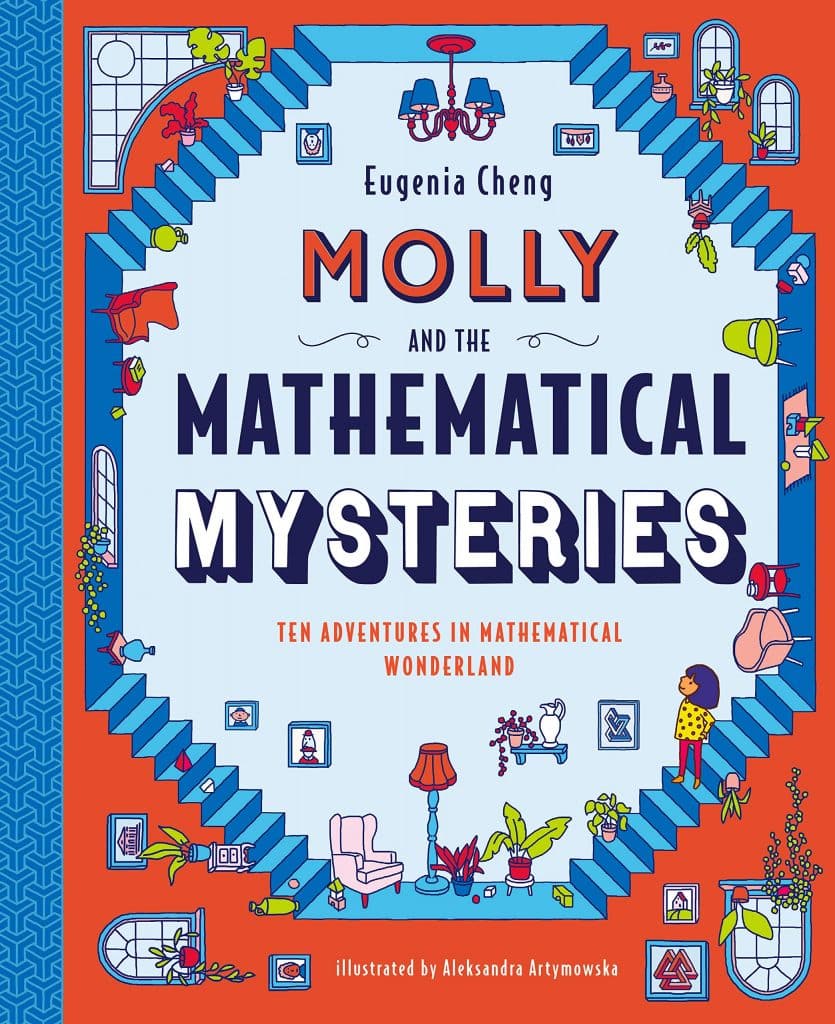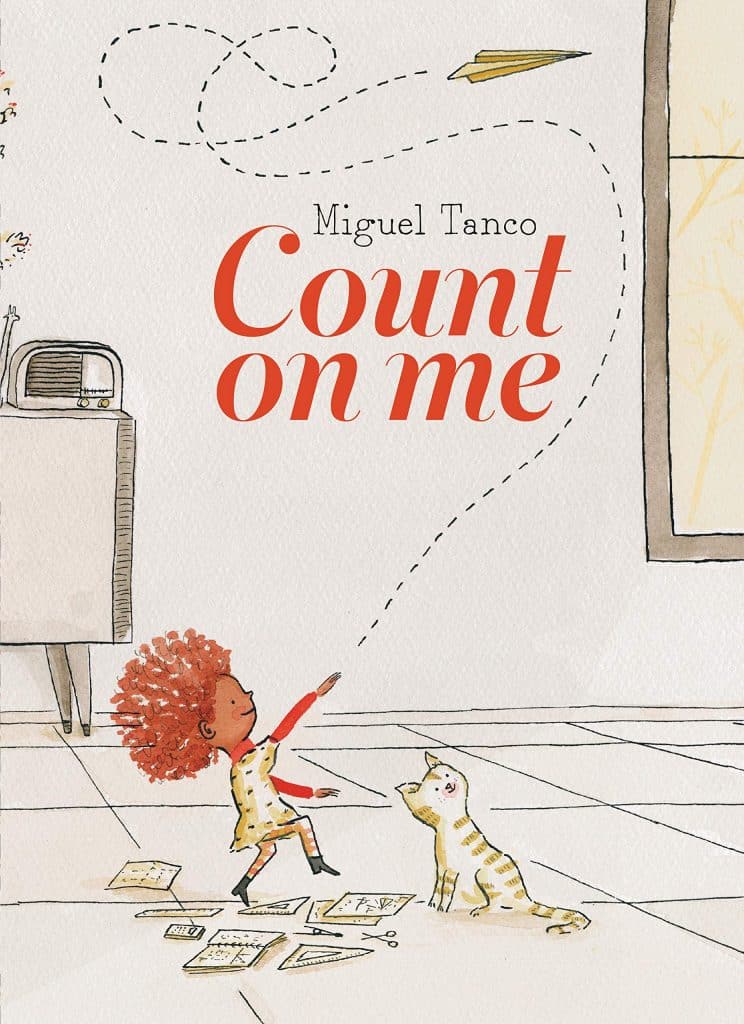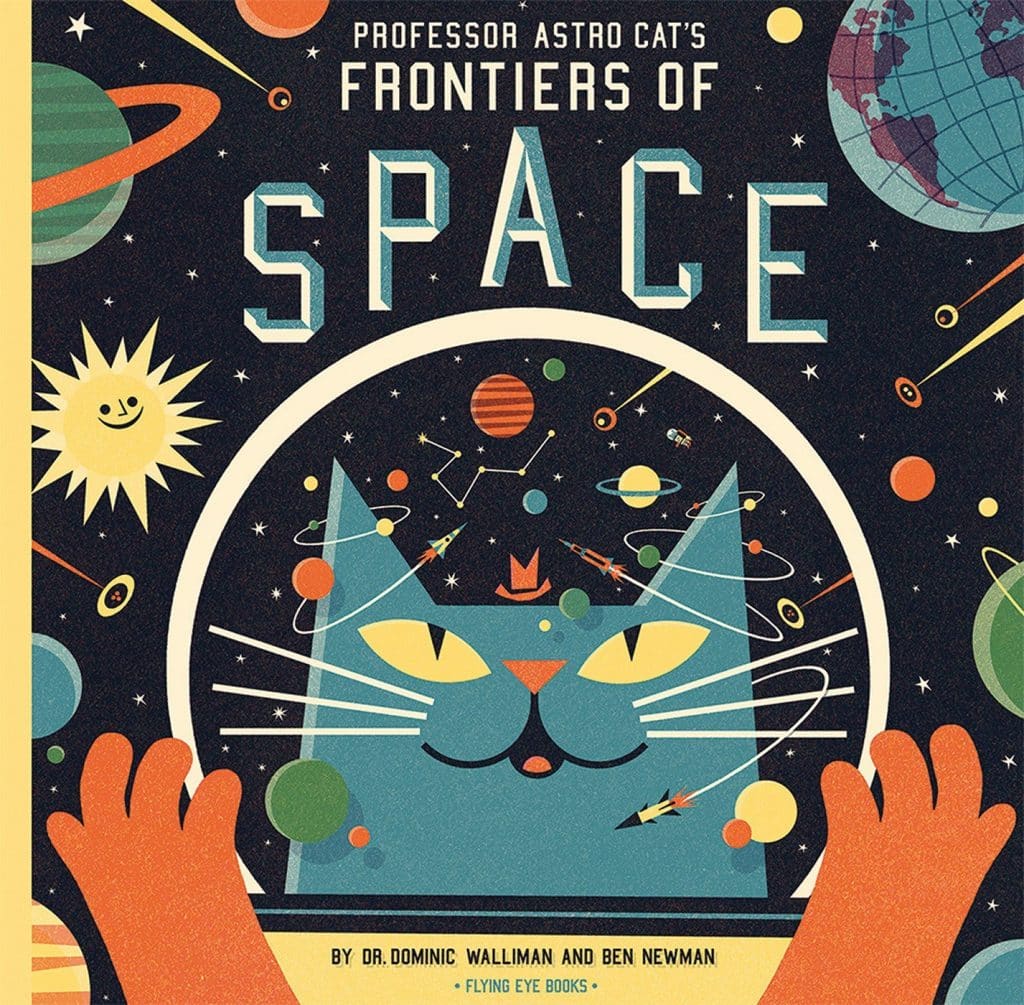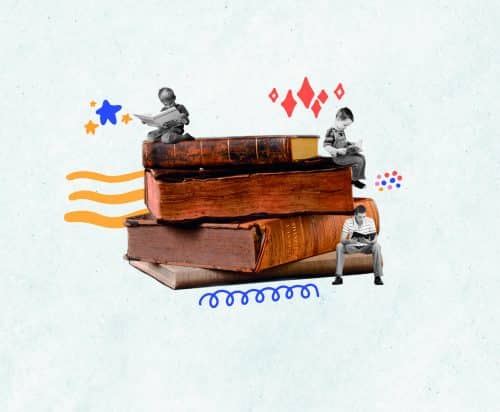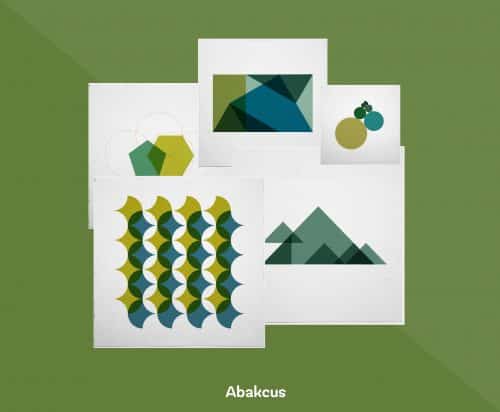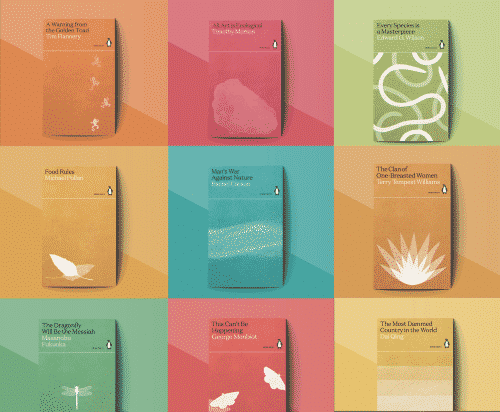STEM books are crucial to a child’s success. (I am not talking about these books) As modern technology continues to advance, industries are becoming more specialized, and the demand for STEM-proficient individuals is higher than ever before. Implementing STEM subjects into your child’s education is essential to prepare them for future career opportunities.
STEM books for kids provide a unique approach to learning about science, technology, engineering, and math and can inspire your child’s enthusiasm toward these subjects. In this directory, you will find 50+ beautiful STEM books for your child’s learning journey.
Why STEM Books Are Essential for Your Kids’ Curiosity?
STEM books for kids provide a wealth of knowledge that cannot be found within a standard textbook. Since children’s books are already filled with diagrams, pictures, and illustrations that bring the material to life, STEM books provide accurate information and teach scientific theory through engaging stories that pique your child’s interest.
In addition, the science projects included in STEM books teach creative problem-solving and critical thinking, which are necessary skills that will benefit your child throughout their adult life.
STEM books offer various reading materials catering to different learning styles. There are books for beginners, intermediate, and advanced learners. STEM books can be read individually or with a teacher or parent to facilitate group discussion or answer questions about the topics. STEM books not only focus on the theories of science but address real-world problems and their solutions, encouraging children to think outside the box and develop innovative solutions.
STEM books are not only interesting and educational but also inclusive. Children with diverse backgrounds and interests can find a STEM book that speaks to them. There are STEM books that cater to specific interests, such as space, robotics, or biology, and books that include characters of all races, genders, and abilities. This inclusivity can help children feel more seen and valued, an essential aspect of child development.
Furthermore, STEM books can prepare your child for future job opportunities. STEM jobs continue to grow, and the workforce requires skilled individuals with a background in STEM fields. Moreover, the number of women in stem is rapidly increasing! Reading STEM books allows children to explore their interests, discover what they are passionate about, and potentially choose a career path. STEM books teach children up-to-date skills and knowledge that employers need in their workforce. They also encourage children to view these career fields through a new, exciting lens.
50+ Awesome STEM Books for Kids to Make Them Love Science, Math, and Engineering!
Again, STEM books are essential in your child’s education as they provide a unique approach to STEM subjects and inspire creativity, critical thinking, and problem-solving. Below, you will find 50+ best STEM books for your kids!
Teachers and parents should encourage the integration of STEM books into their child’s learning experience. Don’t forget that: Reading STEM books is educational, informative, exciting, and fun. Your child can learn about the world around them, develop their interests, and become passionate about STEM fields.

“What is a River?” isn’t just a question asked by a curious child – it’s the title of an enriching exploration penned and illustrated by Monika Vaicenavičienė. This book stands out as a remarkable contribution to children’s literature, particularly within the STEM (Science, Technology, Engineering, and Mathematics) category. It is not only enlightening through its vivid storytelling but also successfully entices young readers into a world of profound natural wonders.
At its heart, “What is a River?” is an ode to the ebb and flow of one of nature’s most vital resource—rivers. Its pages take young readers on a journey across the globe, delving into the geographical veins that sustain both the Earth and its varied cultures. Packed with relevant information about rivers’ scientific aspects, the book does not shy away from the historical and industrial influence these water bodies have had over the years. Moreover, it ignites a sense of environmental stewardship, underlining the indispensable bond between human beings and the natural world.
The underlying message of connectivity remains a fundamental theme throughout the book. By showing how rivers are a lifeline for ecosystems, communities, and civilizations, Vaicenavičienė creates a tapestry interweaving humanity with the environment. It prompts readers – both young and old – to consider our impact and responsibility towards these flowing arteries of the planet.
In addition to the rich content, “What is a River?” shines through its artistic value. Vaicenavičienė’s illustrations are not merely add-ons; they are integral to the storytelling process, enabling a vivid understanding and capturing the imagination in a way that words alone may not. Each drawing acts as a window into various aspects of a river’s existence, aiding children’s comprehension of complex concepts while ensuring the journey through the book’s pages remains magical.
From a didactic perspective, this book is a goldmine. It serves as a crucial resource for educators and parents looking to instill a love for STEM subjects in children. The way “What is a River?” presents its themes allows children to see these topics as exciting mysteries to unravel, rather than dry, scholarly content. It proves that education can be adventurously experiential and interactive, thereby strengthening a child’s cognitive connection to learning.
It’s rare to come across a book like “What is a River?” that so effortlessly merges education with engaging storytelling. As a STEM book for kids, it surpasses expectations by challenging young minds to think beyond the superficial and dive deeper into understanding the fundamental elements of our world.
For any child with a hint of curiosity, this book is more than just a good read—it’s an adventure that can spark a lifelong passion for learning and exploration. “What is a River?” is highly recommended for its ability to teach, inspire, and connect.
Embark on an incredible journey to the tiniest building blocks of our world with Rosie Dickins’ book, “See Inside Atoms and Molecules.” This educational and interactive book is perfect for young readers who are eager to learn about atoms and molecules in an engaging way. With flaps to lift and colorful illustrations, readers will be transported into the microscopic world of atoms and molecules. Through this exciting and hands-on experience, children will gain a deeper understanding of the building blocks of matter and the world around us. So come along and see inside the incredible world of atoms and molecules.
Have you ever wondered where tap water comes from and where it ends up after it goes down the drain? Bridget Heos takes readers on a fascinating journey down the drain in her book, Follow That Tap Water! This book is a great resource for kids curious about the water flowing out of their taps. It explains how water goes through numerous steps to become safe and drinkable and what happens to it before it returns to the environment. With its kid-friendly illustrations, funny water-drop characters, and gross-out moments (think microbes munching on toilet water), this book will keep kids entertained and engaged.
At the end of the book, there is even a suggested experiment that teaches kids the basics of how water filters work. Overall, Follow That Tap Water! is an essential read for any curious kid who wants to learn more about the fascinating world of water.
Grace Hopper: Queen of Computer Code is an inspiring book for kids that tells the story of Grace Hopper, a trailblazing woman who disrupted the computer technology world in the late 1950s. She coined the term “computer bug,” taught computers to speak English, and successfully pursued inventions no one had ever attempted.
With a lighthearted tone and entertaining illustrations by Brooke Boynton-Hughes, Grace Hopper: Queen of Computer Code is a must-have book for any tech-savvy child who will learn all about Grace Hopper’s incredible life story while developing their own coding skills.
A Life Electric: The Story of Nikola Tesla is the perfect book for introducing kids to the fascinating and sometimes overlooked contributions of one of history’s most remarkable scientists.
A combination of Azadeh Westergaard’s lyrical storytelling and Júlia Sardà’s meticulously detailed illustrations evoke a vivid world where electricity is king and readers can explore Nikola Tesla’s secrets. Sure to become one of the best kids’ books on the market, A Life Electric enlightens young minds while filling them with awe-inspiring facts that bridge scientific innovation with everyday life. Enter into A Life Electric and discover why we should be celebrating this extraordinary genius now more than ever!
The Boy Whose Head Was Filled with Stars: A Life of Edwin Hubble is a captivating and inspirational story of one man’s extraordinary journey. The young Edwin Hubble was obsessed with the unknown, often staring at the stars all night, trying to figure out their secrets. He refused to let anything hold him back from pursuing his dream of becoming an astronomer, and ultimately his hard work paid off.
Thanks to Hubble, we know that there are more galaxies than our own and that the universe is ever-expanding – monumental discoveries made possible by a little boy whose head was filled with stars! As such, your child must read this book to gain insight from Hubble’s incredible story, showing them how far dedication and passion can take you.
Don’t you just love it when a good story intertwines with your passion, driving you to explore the intertwining paths of creativity and knowledge? If you are a fan of mathematical fiction and yearn for a narrative that makes the world of math not only accessible but whimsical, you’ll be thrilled by Eugenia Cheng’s “Molly and the Mathematical Mystery.”
In a world where numbers breathe, dance, and hide in plain sight, Cheng’s book, Molly and the Mathematical Mystery takes young adult readers on a joyous journey through the puzzles of prime numbers, the labyrinths of logic, and the interconnected threads of shapes. But it isn’t just a simple math lesson in the disguise of a story; it’s a gripping narrative that highlights the beauty and allure of mathematics.
A Math-Infused Tale: What Is “Molly and the Mathematical Mystery” All About?
At its heart, “Molly and the Mathematical Mystery” is a celebration of math, disguised as an adventure for its young and curious readers. The book centers on Molly, a young girl who moves to a new town and school, feeling isolated and different. However, her encounter with a hidden and mysterious library sets her on a quest to prove herself and unravel secrets that could change everything.
Molly doesn’t possess supernatural powers or high-tech gadgets. Her tool is her intellect, her courage, and her love for math. As she navigates the challenges within the book, Molly finds kindred spirits—fellow students and even historical mathematical figures—who guide her through puzzles and assist in her pursuit of understanding.
Cheng’s book, Molly and the Mathematical Mystery, is much more than a coming-of-age story. It’s a depiction of the math that lurks behind our world and an affirmation that math can be thrilling.
Making Math Fun and Accessible
The greatest triumph of “Molly and the Mathematical Mystery” lies in its ability to make math enjoyable, even for those who shy away from the subject. Cheng gracefully weaves topics like the Sieve of Eratosthenes or the Enigma machine into the plot, taking care to ensure they serve the storytelling rather than stifle it with hard facts.
Through engaging characters and an immersive narrative, Molly and the Mathematical Mystery imparts knowledge about numbers and reasoning structures that are both fundamental and, dare we say, fun. It’s clear that Cheng, a renowned mathematician in her own right, is not interested in simply parading her expertise. Instead, she chooses to share the joy she finds in her field, and passes this energy on to her readers with ease.
A key takeaway is the democratization of mathematics. Cheng believes that everyone can—and should—engage with mathematical thinking. Her book speaks to this belief, fostering an environment where every reader can be a solver and every problem is just another riddle waiting to be tackled.
Demystifying Math: Less Intimidation, More Exploration
Mathematics often carries a reputation of being daunting, a subject that weeds out the weak-minded. “Molly and the Mathematical Mystery” actively challenges this notion, illustrating that understanding numbers is more about approach and perspective than inherent ability.
Cheng’s characters—both human and numerical—emphasize that the way you look at a problem can be more important than the right answer itself. They engage in guesswork, creative strategies, and reformulate their inquiries when a roadblock appears, echoing insights of the mathematical process in a palatable and relatable way.
For most young readers, Molly and the Mathematical Mystery poses a powerful argument: mathematics can be an adventure to be relished rather than a chore to be endured. Each challenge Molly faces is another opportunity for growth and learning, inviting readers to adopt a similar mindset in their own encounters with the subject.
Embracing Problem-Solving as an Adventure
Molly and the Mathematical Mystery infuses a sense of excitement around the very act of problem-solving. Each new equation or puzzle isn’t just another academic exercise; it’s a gateway to a wider understanding and new adventures. “Molly and the Mathematical Mystery” teaches its readers that, through tackling problems, one can unlock doors to worlds both real and imaginary.
Moreover, the narrative encourages the reader to perceive the world through mathematical lenses, sharpening their ability to recognize the patterns and connections that govern our environment. Cheng illustrates that the beauty of math is all around us and that, with the right approach, we can convert any challenge into an opportunity for discovery.
The Perfect Blend: Storytelling, Illustration, and Design
The design of the book is as intentional as its content, with illustrations and layouts that complement the narrative and help immerse the reader in the world of numbers. Visual learners and young audiences are especially well-catered for, with diagrams and visual aids that not only clarify but also add depth to the storytelling experience.
The illustrations serve as a bridge, capturing the essence of geometric shapes or the logic of puzzles, enhancing the understanding of the text. They are neither unnecessary nor overpowering but perfectly balanced, adding to the charm of the story without burdening it with unnecessary weight.
A Conclusion Grounded in Adventure and Wisdom
In a world flooded with technology and fast-paced media, an old library and a mathematical mystery offer refreshing deviation. “Molly and the Mathematical Mystery” is more than just a story—it’s an invitation to pause, to think, and to accept the treasures and challenges that the subject of mathematics presents.
Cheng’s writing style is approachable and charming, engaging the reader in such a way that concepts, which once may have seemed dry or distant, spring to life with color and adventure. It stands as a testimonial to the possibilities when we allow creativity to guide our approach to areas traditionally viewed as mundane.
In the end, Molly and the Mathematical Mystery‘s greatest achievement is to instill in its readers a sense of optimism in the face of problems. It teaches that, in every mystery, there is a mathematical undercurrent—a set of principles at work, waiting to be uncovered.
For the young and the young at heart, “Molly and the Mathematical Mystery” champions a new generation of thinkers and problem-solvers—each one poised to take on the world with a smile, a head full of numbers, and the wisdom that an enigma is nothing to be feared but a joy to be encountered.
As we close the final chapter on Molly’s adventure, it’s hard not to feel that our own journey with mathematics has just begun—a journey filled with joy, anticipation, and, most importantly, endless possibility.
Eugenia Cheng’s work doesn’t merely introduce mathematical concepts; it acts as a catalyst for a love affair with logic and numbers. For any YA reader or adult looking to rediscover the enchantment of pure reasoning, this book stands as an unmissable read. So, are you ready to step into the shoes of Molly and venture into a world where the answers aren’t just numbers but threads in the tapestry of understanding?
In a literary world where numbers are often the villains of the imaginative, Miguel Tanco’s “Count on Me” turns the tables, transforming math into a hero. The story follows a young girl as she embarks on a journey to discover her passion and finds an unexpected ally in the world of numbers. From start to finish, Tanco weaves a heartwarming narrative that celebrates the beauty of math and the individual pursuit of excellence.
The true beauty of “Count on Me” lies in its ability to depict the subject of mathematics not as an abstract concept, but as a vital and engaging part of everyday life. For young readers, this message is paramount, especially for those who might not resonate with traditional tales. Tanco’s whimsical illustrations bring both the girl’s world and the mathematics she loves to life, inviting children to see the equations hidden within their routines and environments. It’s an invitation to appreciate the patterns, shapes, and numerical reasoning that underpin the very fabric of life.
In addition to its numerical spotlight, “Count on Me” stands as a beacon for diversity in children‘s literature. The interracial family at the heart of the story presents a relatable and inclusive example for readers, showcasing the universality of familial love and support. Tanco thoughtfully incorporates diverse representation, offering a reflection of the multi-hued world in which young readers live. It’s a salient reminder that the fascination with numbers knows no bounds, respecting neither race nor gender.
The artwork of “Count on Me” is a marvel to behold. Tanco’s signature style is a testament to his skill and vision, displaying a rich and warm palette that complements the story’s hopeful tone. The inclusion of the main character’s illustrated notebook is not just a charming aesthetic choice but a practical and dynamic teaching tool. For children who are visually inclined, this section serves as an instruction manual for engaging with the numbers and concepts introduced in the book.
In conclusion, “Count on Me” may very well become a cherished addition to a child’s math library. It broadens the horizon of what is possible in children‘s literature by valuing the love of math and encouraging young readers to find and nurture their own passions. Any parent, educator, or young reader who appreciates a good story with valuable takeaways will delight in “Count on Me.” It is a book that counts, indeed.
Professor Astro Cat’s Frontiers of Space
Professor Astro Cat is the smartest cat in the alley. He’s got a degree in just about every discipline under the sun! Speaking of the sun, he happens to be a specialist on that too, and Professor Astro Cat’s Frontiers of Space will tell you everything that there could be to know about our star, our planet, our solar system, our galaxy, and our universe. The professor’s made sure of that; he’s a fastidious little feline!
Professor Astro Cat’s Frontiers of Space also explores topics such as gravity, extraterrestrial life, time, and many other fascinating subjects that will take you and your children on a journey to the very frontiers of space!
William Kamkwamba’s story will tug at your heartstrings and leave you feeling inspired. The Boy Who Harnessed the Wind is a true testament to the power of human ingenuity. Faced with devastating circumstances in his African village, William refused to accept defeat. Instead, he took matters into his own hands and researched potential solutions. What he accomplished next was nothing short of extraordinary. He built a windmill that helped his village pump water to their parched fields and generate electricity for his family. His story is a reminder that even in the most dire of times, hope and innovation can still flourish.
With their intricate plot and thought-provoking themes, these time travel movies will surely keep you on the edge of your seat just like Dark did. So grab some popcorn and settle in for a wild ride through multiple dimensions, alternate realities, and the mysteries of the universe with these interesting time travel movies.
What is STEM book for kids?
STEM book for kids is an educational tool that has gained popularity recently. These books delve into the fascinating worlds of science, technology, engineering, and mathematics, presenting information in a fun and engaging way that captures the attention of young readers.
STEM books for kids come in various formats, from picture books to graphic novels to interactive pop-ups that offer an immersive learning experience. These books are designed to help children develop their critical thinking skills, problem-solving abilities, and creativity, all while exploring the exciting frontiers of STEM fields. By instilling a love of learning early on, STEM books for kids can inspire the next generation of inventors, engineers, and scientists and help unlock a brighter future for us all.
What does STEM stand for kindergarten?
STEM is an acronym that stands for science, technology, engineering, and math. These subjects are introduced early in kindergarten to help children develop a strong foundation in critical thinking, problem-solving, and creativity.
By incorporating STEM education into the kindergarten curriculum, young children can learn how to harness their curiosity and explore the world around them. This approach helps foster a curiosity for learning that will set them on a path to academic and career success. So, if you have a little one in kindergarten, encourage their interest in STEM and watch them thrive.
When should I start STEM education?
STEM education is essential to a child’s education, but when is the best time to start? The answer is simple; the earlier, the better. Early exposure to STEM concepts can instill a love for science, technology, engineering, and math in children from a young age. It allows them to understand how the world around them works and opens up a world of opportunities for them in the future.
From coding to robotics, the possibilities are endless. The key is to make it fun and engaging so they learn while they play. Whether it’s through building blocks, puzzles, or experiments, children are natural problem-solvers. So why not start their STEM education journey early?
Why should my kid do STEM?
There are countless reasons why your kid should explore STEM (science, technology, engineering, and math) fields. Not only do these areas of study offer endless opportunities for innovation and creativity, but they are also crucial for the future of our society. By encouraging your child to explore STEM, you are helping them develop vital skills such as problem-solving, critical thinking, and analytical reasoning.
STEM also offers diverse career paths, from designing cutting-edge technologies to pursuing scientific research. Additionally, by studying STEM, your child can gain a deeper understanding and appreciation for the world around them. Whether your child chooses to pursue a career in STEM or not, exploring these fields can benefit them in countless ways and help set them up for future success.

